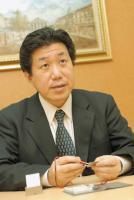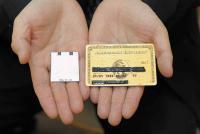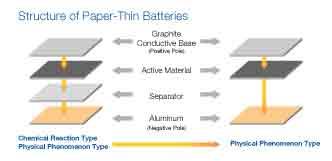J@pan Inc -- Ion Technology
Mobile Power in a Super-Thin Package
By John Dodd / Photos by Andy Rain
 Nobuyuki Tabata
Nobuyuki Tabata
Imagine a battery so thin and simple to make that it can be printed in unlimited quantities on paper or plastic. The opportunities for creative electronic applications would be limitless. Credit cards could be powered, allowing them to be smarter, RFID and other ID chips would have greater range and functionality, electric paper would be truly portable and flexible, and watches and personal health monitors could be manufactured right on to a strap, badge, or even a smart Band-Aid. While the microchips for such applications have been available for a decade and the display technology is just now making its debut, the power source has been the limiting factor. A battery can be made only so small before it no longer provides useful output. And when consumers see the compromises product designers have to make, they wonder, "What use is a paper-thin device if it has a battery lump protruding from it?
However, now a Tokyo-based venture company called Ion Technology has created a true paper-thin battery (not a capacitor) by developing an active solid electrolyte from naturally occurring minerals that when processed can be printed, or pasted, as a powder solution on to paper and plastic base materials for use as a battery. This printing capability allows Ion Technology to project amazing cost savings in producing power cells, possibly up to 50 percent off the current price. Further, the active material forming the electrolyte consists of a mineral powder not used before in batteries, and possesses high energy density. The cells are still under development and apart from R&D samples, which are available now, products won't be released for sale until 2007. However, testing to date has been promising and North Asian consumer electronics firms are taking notice.
The Technology
Although other firms, including those from the US, Japan, Taiwan, China, and Israel, claim to have developed flexible paper-thin batteries, these have drawbacks that are holding up commercialization. Typically they are either much thicker than advertised, possess capacitor-like characteristics and thus have little capacity under load, are made of impractically expensive exotic materials, or have low energy density and so need a large surface area or high volume to deliver power of any use.
 Cells can be printed directly onto a flexible plastic substrate and can be applied in differing thicknesses or in series for higher voltages and power.
Cells can be printed directly onto a flexible plastic substrate and can be applied in differing thicknesses or in series for higher voltages and power.
Ion Technology's breakthrough has been the development of an activated, solid electrolyte made of natural minerals that can be printed between a cell's graphite and aluminum plate electrodes to form a paper-thin power cell. The content of the electrolyte is a patent-pending trade secret, but trial runs of sample products have proven that it not only works, but produces almost ten times the energy density of other paper-thin batteries of the same volume. As an added benefit, Ion Technology says that the new primary (disposable) batteries are completely safe and environmentally friendly.
The key selling point of the Ion Technology cells is their flexibility of application. In their thinnest form, they measure just 0.2mm in height and yet can still provide output of 3.5 volts at 30mA/hr per 4 sq. cm. For thicker media, such as credit cards, the volume of electrolytic material can either be increased for higher power output, or the cells concatenated for higher voltage. This flexibility is important because wireless credit and other prepaid cards are one of the biggest potential markets for the product. Such cards are typically 1mm thick and Ion Technology has already trialed a printable power cell configuration that can supply 30 volts, easily enough to power not only the card but also an onboard display and a data transmitter.
Ion Technology's unparalleled ease of production and high energy density for a given volume is made possible by the fact that the active material needs no separator between it and the two poles. As a comparison, another paper-thin battery maker offers a nominally similar product, a cell with 1.5-volt output and a 600µm thick profile, but which in reality can only provide 30µA/hr of power before going flat. That represents about 20 seconds of write time for the onboard CPU of an intelligent card to a nearby wireless device. In contrast, recent prototypes tested by Ion Technology in March 2006 provided an output of 30mA/hr per 4 sq. cm, well exceeding the competitor's rating for the same surface area. Further, since Ion Technology cells are one-third of the height, two or three layers can be squeezed into the same volume for a total power output that puts competing technologies to shame. This is why Ion Technology is already in negotiations to bring their cells to market, while other manufacturers make product concept announcements but not much more.
 Ion Technology batteries require no separator between poles.
Ion Technology batteries require no separator between poles.
It is power specifications like these, coupled with the low manufacturing cost, that has Japanese, Taiwanese, and Chinese consumer electronics manufacturers lining up to deal with Ion Technology. As one major Taiwanese factory maker commented during a sales pitch, "not only will we get amazing cost-savings, we'll also have flexibility in being able to design power sources that fit the product rather than the other way around." Indeed, Ion Technology sees its best customers as those who have to force fit their electronics into a small size, such as an MP3 player, mobile video, or cell phone.
After seeing the samples and test data, makers are excited enough to start investing in Ion Technology. The result has been that Ion Technology is already cashed up, after an investment in February this year, and has another round under negotiation. Although cash is not an issue, Ion Technology's CEO says that he is still interested in forming international partnerships. For reasons that will become clear later on in this article, he wants a quick global ramp up and is looking for licensees and other partnerships.
More Cells for Autos and Submarines
But paper-thin batteries are not the only product in the Ion Technology arsenal. The company has also adapted its proprietary active material to rechargeable (secondary) lithium cells as well. Dubbed Metal Lithium, the new cells use a combination of ceramic separator and standard lithium cell augmented by elements of Ion Technology's active material electrolyte. Together, the separator and active material work to retard the development of battery-life-shortening dendrite, a kind of parasitic growth on the negative lithium pole of LiO batteries. Although other companies are also experimenting with the use of ceramics for combating dendrite formation, Ion Technology has already tested its new active material construction with manganese batteries and found that it offers significant staying power over other products.
In lab tests, Ion Technology's Ceramic H construction significantly increases the life of manganese batteries. Ion Technology is now discussing with a major automaker the provision of its technology for use in new power cells for electric cars. Ion Technology hopes to tie up with the automaker later this year. Development and testing of the auto batteries is likely to take 10 years.
Following are the target specifications:
Performance: 300km on a single charge
Acceleration: 0-400m in 19 seconds
Max. Speed: 140km/hr
Usage: Commercial delivery and golf buggies
Vehicle Weight: 700kg dry kerb weight
Battery Weight: Less than 100kg
Charging Time: Less than 2 hours
Patent: Pending
Probably the most interesting application of the new Metal Lithium cells is for a vehicle not yet possible, owing to the lack of suitable power sources: a recreational submarine. Ion Technology will turn to this project after the development of the Metal Lithium cells for automotive applications. The company envisions a two-seater recreational submarine that can dive to a depth of 120 meters. Plans call for the production of 200 units, priced at JPY100m (US$850,000) each. An expensive toy or an illegal immigrant's dream? No matter, just as private airplanes, despite their expense, have gained a dedicated following in the private sector, Ion Technology expects that exploration of the seas represents a similar thrill at similar cost. The company notes that it will prioritize sub development if the right investor comes along.
The Force behind the Power
You wouldn't think it, meeting the energetic and smiling CEO of Ion Technology, Nobuyuki Tabata, for the first time, but he insists that as a child he was both sickly and withdrawn. He was on a new drug for severe asthma at the time, and he now reckons it caused him more problems than benefit. During the worst five years he spent most of the time in bed reading books and thinking about the world around him. For some reason, in his early teens he got the idea that he should take up judo to recover, and as luck would have it, wound up at a dojo run by a strict judo master. The sensei insisted that Tabata drop the drugs, change his diet to include whole foods such as brown rice, and get sufficient exercise.
It was a leap in faith, but it turns out that the master was right. By his mid-teens Tabata was thriving again. But he never lost his love of books and sessions of simply wondering about the meaning of life and nature. In particular, he was fascinated by rocks and minerals, and started pondering how to apply their characteristics to both furthering the well-being of mankind, and making money too.
Tabata completed a two-year tutorial in company management under Akira Yamashiro, a professor emeritus of Hitotsubashi University. Professor Yamashiro was proselytizing the merits of venture business in Japan's mature markets and awoke in his student an entrepreneurial urge. But also, he emphasized the importance of knowledge and systems. So the young Tabata decided to learn the basics of business first. He went on to became an accountant, then an accounting teacher. However, five years later, he rejoined Yamashiro-sensei, who had created the SME diagnosis consultant certification recognized by the Japanese government.
Eventually, Tabata felt he had absorbed enough learning, and at 30 he set up his first company: using rocks, or more specifically ceramics, to purify and recycle domestic bath water so as to reduce wastage. Using Tabata's original materials, a bath could be filled once and the same water used repeatedly over a number of days without deterioration. Although his system worked, the venture taught Tabata the realities of the market: that even good ideas have to be sufficiently compelling for consumers to buy them. Unfortunately, water in Japan is remarkably cheap and eco-sensitivity was not trendy back then. So after 18 months of operation and struggle to educate the market, an impatient supplier sold off his promissory notes to a financial institution, which then closed him down.
At 32, Tabata was JPY80m (US$680,000) in debt and had learned an important lesson: creativity and business are difficult to mix. Once again, he went to work for someone else, but just couldn't get his love of rocks out of his head. In 1989 he joined a health products distributor, remaining in that sector for the next 10 years before establishing Ion Technology in November of 2004.
Rocks. Tabata is obsessed with them. Over the last 20 years he has analyzed many kinds of rocks, derivative minerals, and their properties. Some years ago, he happened upon a mineral that produces a weak form of electricity naturally. In 2003 he decided to try to isolate the active material and process it into a purpose-made ceramic. He succeeded and today that is the active material that forms the heart of Ion Technology's batteries.
A revealing fact about Tabata is that he tries to read 500 books a year to keep ahead of the curve. Of course, doing this and holding down a job at the same time would normally be impossible, but several years ago he discovered an obscure title in Japanese that purports to help readers survive on just three hours sleep a night, within just three weeks practice of the regime. Tabata decided to try it and was able to comfortably get by on three hours of sleep a night after three months. Ever since, he has used the other five hours for reading!
Delivering to the Market
There is some serious buzz going on in Tokyo and Taiwan about the Ion Technology products. Samples are being delivered and competitors, some years behind the curve, are watching Ion Technology closely. Tabata worries about the theft of his intellectual property, even with patents pending. So his strategy has been to involve his own heavyweight partners in commercializing the technology before someone else does. His first round of serious venture funding took place in February 2006, and now that he is well capitalized, final R&D is taking place prior to setting up a trial production line in Taiwan, with a target to move to a full-blown facility within two years. His main partner is a family member of one of Taiwan's largest manufacturing companies.
Tabata estimates that because his batteries can literally be printed on to the base plastic or paper carrier, he can reduce the manufacturing cost of a credit card cell to about 50 yen a piece—clearly an epochal event in that sector. In Japan alone, the overall market for batteries is about JPY700bn (US$5.98bn), of which 4.6bn units, or JPY540bn (US$4.6bn) worth, are disposable batteries.
Batteries are an indispensable part of modern life, offering mobility and reliability for users of all kinds of devices. Nowhere more so than in North Asia have consumers embraced the mobile lifestyle. For example, Japanese consumers own more than 100 million cell phones, 270 million credit and similar stored-payment cards, and an estimated 200 million personal entertainment and information devices. China has 400 million cell phone users, and about 700 million credit cards issued yearly. This region is a huge market with a need for low-cost portable power.
Tabata's challenge is to get his technology to market before one of the many other larger companies in the same space beat him to it. While he is confident that his manufacturing process and origin of active material are secure for the time being, in his own words, “It is only a matter of time before companies with R&D resources start to understand then emulate what we have." He would prefer to get his product to market quickly rather than have to sue for patent infringement in court later.
While Tabata has been reticent to date, as he develops his technology, he is now eager to talk to foreign firms who have R&D and distribution capabilities in their home markets and who would be interested in doing business with Ion Technology. Below are the contact details for Tabata and Ion Technology. JI
Ion Technology Inc.
President: Nobuyuki Tabata
GF Building 3F 2-14-9 Ginza, Chuo-ku
Tokyo 104-0061
Tel: 03-6278-0516
Fax: 03-6278-0517
http://www.iontec.jp
Email: info@iontec.jp and info@japaninc.jp






Comments
Raj Gauri (not verified)
August 21, 2009 - 11:45
Permalink
updated contact info for Nobuyuki Tabata
Hi,
Is is possible to get an updated info on Ion Technologies and its ultra thin disposable batteries?
Thanks